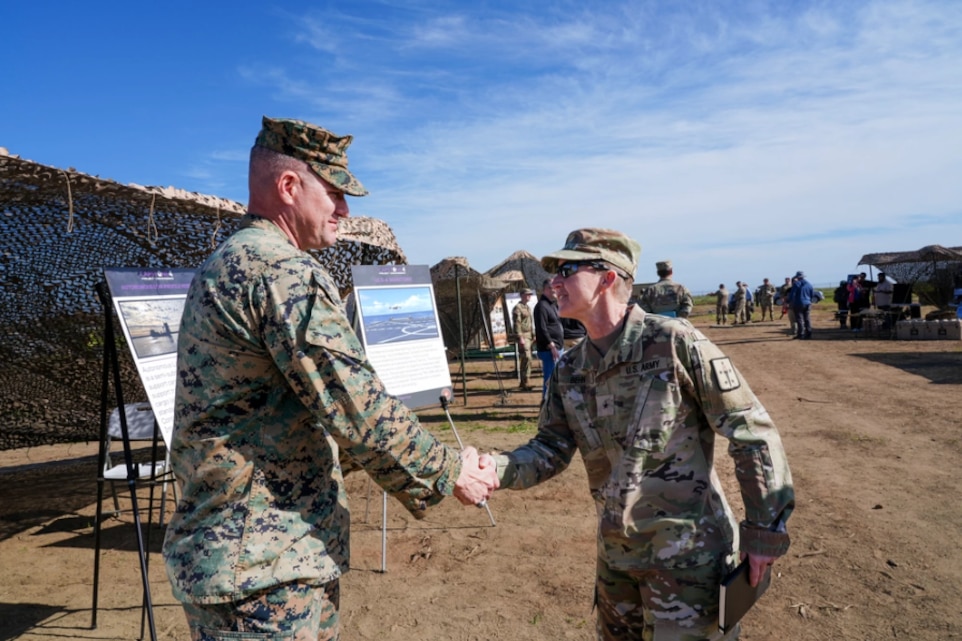Last month, the Marine Corps showcased its adaptability and forward-thinking approach to modern warfare through its participation in the Army’s Project Convergence Capstone 4, or PC-C4. With a focus on leveraging advanced air and missile defense systems, sensor capabilities, and fostering unmatched interoperability with allied and Joint Force partners, this landmark experiment represented a pivotal moment in the Marine Corps’ journey towards realizing its ambitious Force Design modernization goals.
Key to this effort was Marine Corps Tactical Systems Support Activity’s strategic collaboration with the Marine Corps Warfighting Lab to successfully execute Use Case 1, or UC-1, which integrated fires and multidomain operations.
Held between February 23 and March 20, 2024 aboard Marine Corps Base Camp Pendleton and other locations across the United States and abroad, the experiment highlighted the Corps’ ability to integrate cutting-edge technologies and operational concepts. This endeavor not only showcased the Corps’ commitment to enhancing joint and allied force effectiveness through advanced air and missile defense systems and sophisticated sensor capabilities but also played a critical role in advancing the Department of Defense’s combined joint all-domain command-and-control, or CJADC2, initiatives.
“In UC-1, our focus was squarely on the concept of integrated fires—this means executing defensive and offensive actions simultaneously,” said LtCol. Brock Lennon, Field Testing Branch Head at the Marine Corps Warfighting Lab and UC-1 Lead Planner. “Essentially, we’re talking about enhancing our air missile defense capabilities to protect our forces while also being aggressive in targeting enemy positions, whether they’re on land or at sea. The complexity of modern warfare demands that we’re adept at clearing threats from the air to secure our offensive operations and simultaneously shield our vital assets from enemy attacks.”
This experiment was crucial as it represented the first live-force experimentation with the concept of a multidomain corridor, an innovative approach introduced by the Marine Corps Warfighting Lab to create a temporal maneuver space. By leveraging the joint coalition kill web to establish control from the seabed to space, UC-1 aimed to test and validate the ability to open strategic areas for operations, facilitating a comprehensive evaluation of integrated fires within a truly joint and combined context. This not only pushed the boundaries of current military capabilities, but also proved a critical component of simultaneous experiments, like UC-4, enhancing the Corps’ logistical and operational flexibility in all domains.
“In addition to joint integrated fires experimentation, MCTSSA and MCWL experimented with emerging capabilities the Marine Corps could provide to the joint force.” Maj Steven Gore, Naval Integration Lead, MCTSSA.
“We demonstrated the Marine Air Ground Task Force command and control, or MAGTF C2, MVP’s ability to execute joint fires during PC-C4 and prepared for future experimentation outside of the lab. We validated multiple sensor integration capabilities to include weapon track quality improvement for commercial radars, modifying a counter-battery radar to perform drone and air-surveillance, and remoted both radar measurement data and control over a satellite network. We also demonstrated the ability to provide C2 capabilities to the Navy through a CAC2S Afloat system and by providing software that increased the weapon control system capabilities on a Littoral Combat Ship and a Guided-Missile Destroyer.”
Furthermore, the joint force collaboration witnessed during this experiment underscored the value of integrating capabilities across the Army, Navy, Air Force, Marine Corps, and Space Force– alongside international partners. By pooling diverse assets such as sensor netting, air defense, and command and control capabilities—from Patriot systems to guided-missile destroyers and cutting-edge aircraft—this collective effort exemplified how interoperability and shared strategic objectives amplify the overall combat effectiveness and operational flexibility of each participating force.
This approach not only leverages the unique strengths of each service but also fosters a unified front that is crucial for addressing contemporary and future security challenges—a pillar of Force Design’s modernization doctrine.
Ultimately, Marine Corps Systems Command’s engagement in these sophisticated experiments, particularly with the multidomain corridor and sensor netting across the joint and coalition forces, underscores a strategic pivot towards enhanced situational awareness, offensive and defensive capabilities.
“The tight partnership between MCTSSA, MCWL, the DC I’s Information War Room, and the Fleet Marine Force in our labs, is absolutely critical to delivering the future capabilities Marines need to win the reconnaissance/counter-reconnaissance fight while enabling Joint and Coalition partners,” said Col. Craig Clarkson, Commanding Officer of MCTSSA.
This not only fortifies the Corps’ lethality and survivability but also solidifies its role as a pivotal player in shaping a future-ready, interoperable, and technologically superior joint force.
More Media
This article, Experimentation Proves Successful for Marines, was originally published by The Marine Corps.








